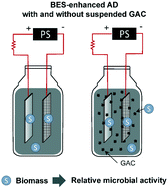当前位置:
X-MOL 学术
›
Environ. Sci.: Water Res. Technol.
›
论文详情
Our official English website, www.x-mol.net, welcomes your feedback! (Note: you will need to create a separate account there.)
Increased applied voltage in the presence of GAC enhances microbial activity and methane production during anaerobic digestion of food waste
Environmental Science: Water Research & Technology ( IF 5 ) Pub Date : 2020/01/08 , DOI: 10.1039/c9ew01000a Moustapha Harb 1, 2, 3, 4 , Noel Ermer 5, 6, 7, 8, 9 , Christelle BouNehme Sawaya 1, 2, 3, 4 , Adam L. Smith 5, 6, 7, 8
Environmental Science: Water Research & Technology ( IF 5 ) Pub Date : 2020/01/08 , DOI: 10.1039/c9ew01000a Moustapha Harb 1, 2, 3, 4 , Noel Ermer 5, 6, 7, 8, 9 , Christelle BouNehme Sawaya 1, 2, 3, 4 , Adam L. Smith 5, 6, 7, 8
Affiliation

|
Suspended conductive materials and bioelectrochemical systems (BES) have independently been shown to improve methane production by enhancing anaerobic digestion (AD). Little is known, however, about their potential combined effect in AD systems. This study investigates a BES–AD system with and without granular activated carbon (GAC) supplementation under applied voltage ranges of 1.25 V and higher. Results indicated that the BES–AD system with GAC could achieve robust methane production (>300 mL CH4 per g COD) from food waste at up to 2.75 V, whereas the BES–AD system alone did not. Microbial analysis revealed that improved performance of the BES–AD system with GAC coincided with higher relative activity of exoelectrogenic bacteria (Geobacter) on anodic biofilms. This advantageous application of GAC also resulted in Methanospirillum emerging as a dominant contributor to methanogenic relative activity in cathodic and GAC biofilms. These observations suggest that suspended GAC can serve to enhance the already beneficial coupling of BES with AD.
中文翻译:

在GAC存在下增加的施加电压可提高食物垃圾厌氧消化过程中的微生物活性和甲烷生成量
悬浮的导电材料和生物电化学系统(BES)已被独立显示通过增强厌氧消化(AD)来提高甲烷的产生。但是,关于它们在AD系统中的潜在综合影响知之甚少。这项研究研究了在1.25 V或更高的施加电压范围内添加或不添加颗粒状活性炭(GAC)的BES-AD系统。结果表明,带有GAC的BES-AD系统可在高达2.75 V的条件下从食物垃圾中获得强劲的甲烷生产(每克COD大于300 mL CH 4),而仅BES-AD系统不能。微生物分析显示,GAC可以改善BES-AD系统的性能,同时还可以提高外生电细菌的相对活性(Geobacter)在阳极生物膜上。GAC的这种有利应用还导致甲烷螺旋菌成为阴极和GAC生物膜中产甲烷相对活性的主要贡献者。这些观察结果表明,悬浮的GAC可以增强BES与AD的有益结合。
更新日期:2020-03-05
中文翻译:

在GAC存在下增加的施加电压可提高食物垃圾厌氧消化过程中的微生物活性和甲烷生成量
悬浮的导电材料和生物电化学系统(BES)已被独立显示通过增强厌氧消化(AD)来提高甲烷的产生。但是,关于它们在AD系统中的潜在综合影响知之甚少。这项研究研究了在1.25 V或更高的施加电压范围内添加或不添加颗粒状活性炭(GAC)的BES-AD系统。结果表明,带有GAC的BES-AD系统可在高达2.75 V的条件下从食物垃圾中获得强劲的甲烷生产(每克COD大于300 mL CH 4),而仅BES-AD系统不能。微生物分析显示,GAC可以改善BES-AD系统的性能,同时还可以提高外生电细菌的相对活性(Geobacter)在阳极生物膜上。GAC的这种有利应用还导致甲烷螺旋菌成为阴极和GAC生物膜中产甲烷相对活性的主要贡献者。这些观察结果表明,悬浮的GAC可以增强BES与AD的有益结合。


























 京公网安备 11010802027423号
京公网安备 11010802027423号